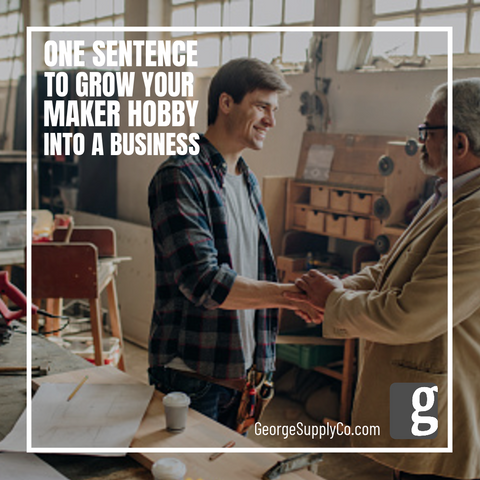One sentence to grow your maker hobby into a business

Ok, yes it takes more than 1 sentence to grow your hobby into a business. But there is one sentence that’s critical. But before we jump into it…
When asked, “what do you do?”, how often do you answer “I’m a woodworker”?
And you immediately regret your answer. I know you’ve been there.
We have forced the prospective customer to guess the specifics.
“Like tables and stuff?”
“Can you fix my broken chair?”
“Can you put a railing on my porch?”
“Can you make my kids a bunk bed for $200?”
Now YOU are forced to say you don’t do some, or even ALL of those things. This immediately diminishes your skill set in the eyes of your customer, having never even seen any of your craftsmanship.
So how do you avoid this? What would have been a better answer to the question “What do you do?
How do you make your business make sense to others?
How can you explain what you do quickly and clearly?
How can you describe your business in 1 sentence?
That one sentence is what we call a business one liner, and it’s the one sentence you need to grow your maker hobby into a business and brand.
Let’s create one line that clearly describes what you offer, and why they should work with you.
Here are the 3 steps to create just that.
Step 1. What problem do you solve?
What need does your product fill, that the customer can't fill themselves. This is not what product you sell, but rather what need does that product fulfill. For example:
- You’re not selling cutting boards, you are solving a gift giving dilemma
- You're not selling cabinets, you’re selling the kitchen of their dreams
- You’re not selling tables, you’re selling memorable family occasions gathering around the dinner table
- You’re not selling leather belts, you’re selling style and fashion
Step 2. The Solution.
Why should those customers purchase from you instead of anyone else? Why is your solution the best option?
- Do you offer the highest quality?
- Do you specialize in a particular item, or medium, or technique?
- Do you offer customization, like engraving, or size or color?
- Do you specialize in urban lumber, reclaimed wood, sustainability, or support a particular cause?
Step 3. The Outcome.
What should the customer expect after they choose your solution? How will their problem be solved, and their life will be better?
- They will have the kitchen of their dreams?
- They will experience the joy of giving the best gift at the party?
- They will have the entire family gathered around the Thanksgiving table?
- They will receive admiration for their style choices?
Now, put those answers together, and you have your business 1 liner: a theme that should be present, either overtly, or subconsciously, in all your messaging.
Let’s try an example
Assume your sell hardwood and epoxy cutting boards, charcuterie boards, and beer flights
- The Problem you solve:
- I never know what gift to give.
- I don't have time to shop
- I don't know what they like
- The Solution.
- You offer a unique cutting board featuring:
- Laser personalization
- Highest quality craftsmanship
- Hand crafted
- Local hardwoods from Pacific Northwest
- The opportunity to support local small business
- The Outcome
- A thrilled gift recipient
Possible business 1 liner:
Parker Woodworking: Give the gift of unique handcrafted charcuterie and cutting boards, featuring only local PNW hardwoods, personalized for your special occasion.
Where to use your one liner
You’ve crafted a tool that quickly identifies your business and the advantages of working with you. Now use it to identify your brand on all your printed and online marketing, such as:
- Website banner
- Instagram bio
- TikTok bio
- Linkedin bio
- Twitter bio
- Business Cards
- Product Information and Thank You cards
- Letterhead
- Shop Banner or Sign
- Emails
Summary
Constructing a clear one liner involves reinforcing that message throughout the buyer journey. Whether it’s in your social media where you attract new customers, your website where they shop, or the Thank You cards after purchase. It’s a constant process of reminding potential customers what problem you solve, and why only you can do it to achieve the outcome of their dreams.
Have questions about building your maker brand and business? Subscribe to the Business for Makers Blog and Business for Makers Podcast for insights and tips. Tune to Sawdust Talk on IGTV Live on Wednesdays at 10 pm CST to hear from makers about their projects and business and meet some great members of the maker community.
Check out georgesupplyco.com for more resources for growing your maker business!

ABOUT THE AUTHOR
Scott Chervitz is owner of George Supply Company, dedicated to helping woodshops build their brand. See more at GeorgeSupplyCo.com. You can reach him at Scott@GeorgeSupplyCo.com, on Instagram at @GeorgeSupplyCompany or Twitter @ScottChervitz
